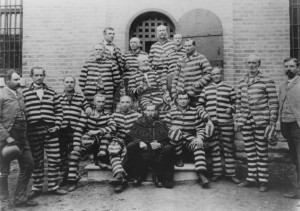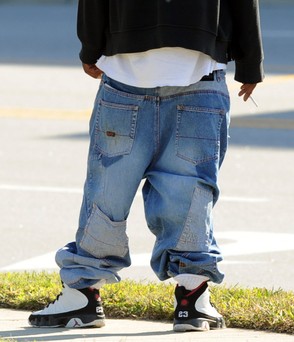Sagging Pants, Criminality, and Prison Clothing
Over the past few days, I have seen a couple of articles addressing the issue of sagging pants. Just yesterday, I read about a city council in Florida that has voted to fine people up to $250 for wearing saggy pants.
The city of Opa-Locka voted unanimously Wednesday night to fine people $250 if they don’t pull their pants up.
Opa-Locka city leaders decided to expand the current ban on saggy pants to include a $250 fine or 10 hours of community service for those who refuse to tighten their trousers.
Opa-Locka City Commissioner Timothy Holmes led the charge against the sagging crowd, saying the low-pants practice intimidates the public, provides a distraction in schools and is a blight on the community.
“Dress like somebody. Be somebody,” Holmes said. “It’s time for us now to try to teach our people how to dress.”
The ACLU has expressed its opposition to this new ordinance:
The American Civil Liberties Union of Florida also objects to the proposal. In a statement to Local 10, an ACLU attorney said, “Policymakers acting as ‘fashion police’ is a ridiculous waste of public resources. Laws like this disproportionately penalize African-American youth, increase contact between youth and law enforcement and will impose overly harsh penalties for victimless behavior.”
One might wonder what the sponsors of the ordinance were thinking about in advancing this policy. Fortunately, we can hear from the main sponsor Commissioner Timothy Holmes himself:
“That might get rid of some of the crime on the street,” Holmes said.
So fining people for wearing their pants “too low” will have the added benefit of improving community safety? This is in fact one of the arguments being advanced. I think that it was Dream Hampton who tweeted a few weeks ago that the banksters on Wall Street who tanked the economy to the tune of $14 trillion in lost wealth were all wearing belts and suits.
Notice the interesting way that Mr. Holmes associates the concept of illegality and criminality with this particular form of dress. As the ACLU rightly points out, the targets of this new ordinance will be disproportionately young men of color. Once again society is inscribing their identities as “criminal” above all. Young white suburban men will not be the ones receiving these fines even if they too come under the gaze of law enforcement for wearing “sagging pants.” Their identities are not synonymous with criminality and as such they are afforded the right to wear such clothing as a marker of “style.”
Sociologist Mary Waters coined the term “ethnic options” to underscore the fact that white people are able to decide when they want to identify with their ethnicities (irish, russian, italian) while people of color in the U.S. do not have the option of choosing when to be ethnic. They are always perceived as “ethnic.” I would apply this concept to the identity of “criminal” for young people of color. They never have the “option” of putting that label on or taking it off.
As has been pointed out in the past, the style of sagging pants is said to have originated in prison culture where prisoners are denied access to belts. So we can see that clothing crosses over from the inside to the outside. Over the past few weeks, I have read a few pieces about prison clothing. Most recently, the Seattle Times reported that in order to save some money Washington State had begun to issue recycled underwear to prisoners.
Officials with the state Department of Corrections have announced several new and creative ways to reduce costs, including giving inmates hand-me-down uniforms and underwear, buying them shorter socks and replacing self-serve cafeteria juice fountains with juice boxes.
Juliet Ash (2010) has written in her excellent book “Dress Behind Bars” that:
Penal institutions, under the authority of particular States, use dress strategically to diminish the imprisoned. Prison clothing takes many forms, whether as uniforms or in the neglect of the maintenance & distribution of clothing (p.3).
Who cares about prison clothing? some readers may ask. Yet we’ve all heard the term ‘clothes make the man.’ We care about prison clothing because it is an “embodiment of punishment.” We are concerned with prison clothing because it relates to the maintenance of fundamental human rights. It seems to me that everyone deserves access to clean underwear at a minimum.
The history of prison clothing and uniforms is a fascinating one. Just a couple of weeks ago, Slate published an interesting article about when and why American prisoners started dressing in orange jumpsuits.
 Many people probably think about the icononic American prison uniform as a black and white striped one. That stripped uniform emerged in 1815 at Newgate Prison. As Juliet Ash writes:
Many people probably think about the icononic American prison uniform as a black and white striped one. That stripped uniform emerged in 1815 at Newgate Prison. As Juliet Ash writes:
“The reason for its adoption was primarily the cheapness of the production of simple black-and-white striped cloth. Additionally the black-and-white horizontal stripes symbolically represented prison bars that not only surrounded the inmate but were also imprinted on the convict’s body and thus became an embodiment of imprisonment (p. 25).”
Prison clothing is not incidental to how we construct criminal identities in American culture. In fact across history, prison clothing is an embodiment of punishment. Because young people are always appropriating styles that they see as “cool,” they have adopted sagging pants as markers of “coolness.” Adults, as they have throughout history, are resisting young people’s self-expression. In this particular case of sagging pants, some have decided to criminalize the young people who wear them. It seems important to point out to these adults that this is supremely unhelpful and will not accomplish their goals. If anything, it is counterproductive and detrimental. I hope that examples like the Florida ordinance do not signal a national trend.
Note: The Crime Report has a good roundup about issues relating to sagging pants ordinances.


By A., December 15, 2010 @ 7:01 am
Just a few years ago, WA State was one of the only states where prisoners were allowed to wear their own clothes. But now look at what has become of the prison system in that state! Ridiculous to issue secondhand underwear. Then the prison issued clothes became compulsory (to save money! was the argument then). Surely there are other ways to save money, what about shorter sentences? Less recidivism?
And well, when in Iran or Afghanistan women are punished for the ‘wrong clothes’ by police, it is all wrong, but in FL it is okay?
Stand up saggy pants wearers!
From a (former) clothes buyer for a friend in prison.